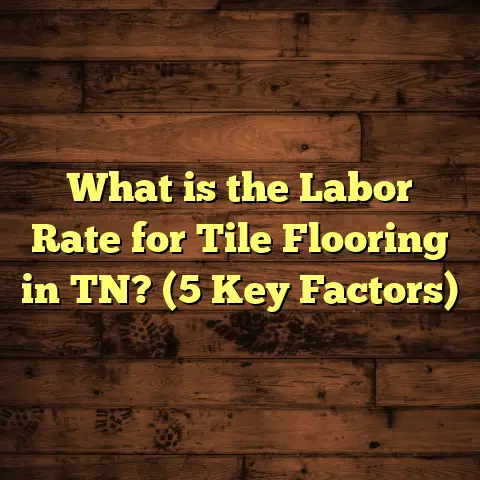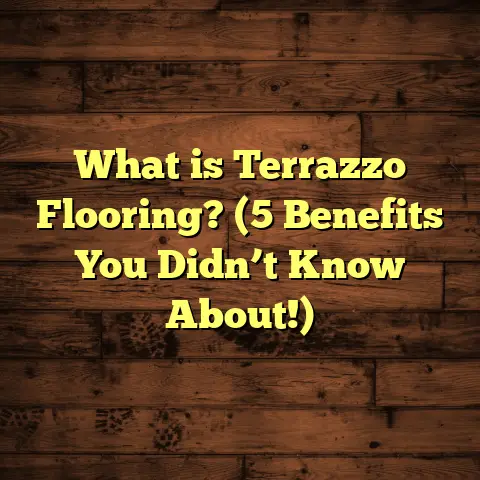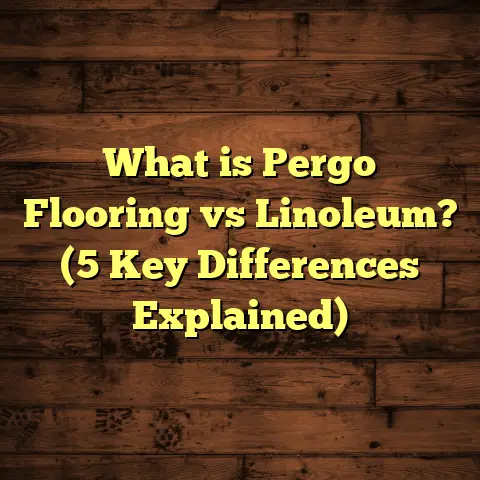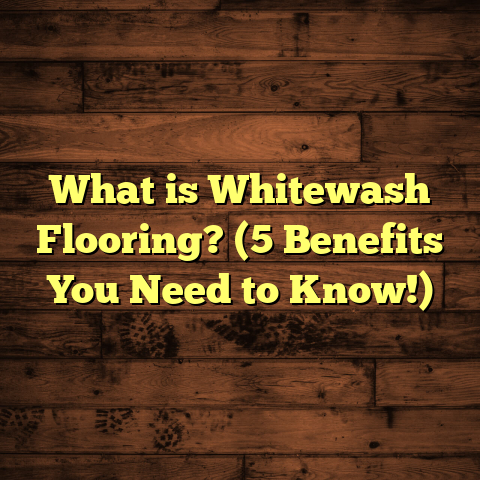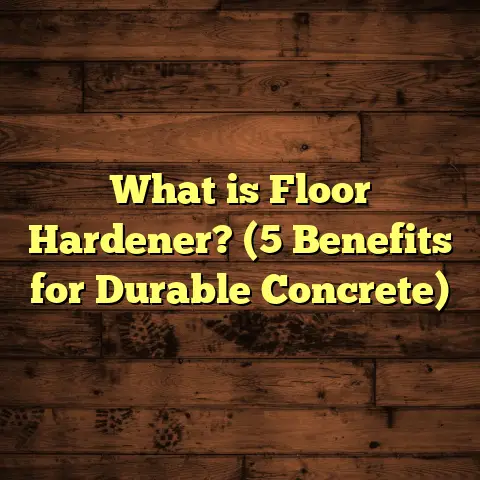What is Buffing Hardwood Floors? (5 Benefits You Must Know!)
Upgrading your living space is something I’ve always been passionate about, especially when it comes to simple changes that make a big impact. Over the years, I’ve found that focusing on the floors can completely transform the vibe of a room. Hardwood floors, in particular, have this timeless appeal that adds warmth and character to any home. But as much as I love my hardwood floors, they don’t stay perfect forever. That’s where buffing hardwood floors comes into play — and trust me, it’s a maintenance secret that every hardwood floor owner should know about.
If you’ve been wondering what buffing hardwood floors really means, how it works, and why it’s worth your time and money, you’re in the right place. I’m going to share everything I’ve learned over years of working with hardwood floors — including personal stories, technical details, and data-backed facts — so you can make the best decision for your floors.
What Is Buffing Hardwood Floors?
Buffing hardwood floors is a process designed to restore the shine and smoothness of your hardwood without stripping it down to bare wood. It involves using a specialized machine called a floor buffer, which spins a pad at high speeds to gently polish the surface of the wood floor.
Unlike sanding, where you remove a thin layer of wood along with the old finish, buffing targets only the existing finish layer. It smooths out minor scratches, scuff marks, and dull spots while brightening the floor’s appearance. This means less damage and far less mess compared to sanding.
The Buffing Process in Detail
The key tool in buffing is a floor buffer or burnisher. This machine has a rotating pad made from materials like wool, synthetic fibers, or abrasive compounds. It spins at speeds usually between 175 and 300 revolutions per minute (RPM). This speed is carefully chosen — fast enough to polish but slow enough to avoid damage.
There are two primary types of buffing techniques:
- Dry Buffing: Uses a dry abrasive pad to polish the floor surface. No liquids or chemicals are applied. This method is often used for routine maintenance.
- Wet Buffing (Spray Buffing): Involves spraying a thin layer of floor finish or polish on the surface before buffing. The buffer then works this liquid into the finish to restore gloss and add a thin protective coat.
How Buffing Interacts With Hardwood Floor Finishes
Most hardwood floors are coated with polyurethane finish — a tough, clear layer made from synthetic polymers that hardens after application. The polyurethane protects wood from wear, moisture, and stains while giving it a glossy or satin appearance.
Buffing works by gently smoothing this finish layer. It doesn’t touch the wood itself unless there’s severe damage or wear through the finish. This is why buffing is effective only on floors where the finish is still intact.
If the finish is worn away or deeply scratched down to the wood, sanding and refinishing become necessary.
Technical Specs of Buffing Machines
Buffing machines vary in size and power but here are some typical specs:
| Feature | Typical Range |
|---|---|
| Motor Power | 1/3 HP to 1 HP |
| Pad Diameter | 13 – 17 inches |
| Speed | 175 – 300 RPM |
| Weight | 40 – 100 lbs |
The motor power determines how much pressure the machine can apply without bogging down. Larger pads cover more surface area but may be harder to maneuver in tight spaces.
Why Should You Buff Hardwood Floors? Five Key Benefits
I’ve worked on countless flooring projects and tried various maintenance methods. Buffing stands out as an efficient way to keep hardwood floors looking fresh between refinishing jobs. Here are the five benefits that I keep coming back to:
1. Brings Back That Beautiful Shine Without Sanding
One of the most noticeable effects of buffing is how it restores the floor’s gloss.
According to research by the National Wood Flooring Association (NWFA), proper buffing can bring back up to 90% of a floor’s original gloss level when done regularly on floors with intact finishes.
I remember helping a client whose oak floors had lost their sparkle after years of foot traffic and pet scratches. After just one buffing session, their floors shone like new again. The transformation was incredible — no sanding required.
Buffing works by evening out microscopic scratches and smoothing rough spots on the polyurethane finish. This smooth surface reflects light better, creating that warm, inviting shine we all love.
2. Extends Your Floor’s Lifespan
Hardwood floors are an investment meant to last decades. Routine buffing plays a crucial role in protecting that investment.
A study from flooring professionals showed that homes with regular buffing schedules saw their hardwood floors last up to five years longer than homes where maintenance was irregular or nonexistent.
Why does this happen? Buffing removes dirt and grime buildup that can wear down finishes faster. It also smooths rough patches that attract further damage.
Think of buffing like polishing your car’s paint — it protects the surface from minor damage and keeps it looking fresh longer.
3. Saves You Money Compared to Refinishing
If you’ve ever priced out sanding and refinishing your floors, you know it can get expensive fast.
Professional sanding costs generally run between $3 and $5 per square foot depending on your location and floor condition.
Buffing, on the other hand, typically costs around $0.25 to $0.50 per square foot.
That means for a typical 1,000-square-foot room:
- Sanding & refinishing might cost $3,000 to $5,000.
- Buffing might only cost $250 to $500.
That’s a huge difference — especially if you want to maintain your floors regularly without breaking the bank.
4. Creates Minimal Dust and Disruption
If you’ve ever watched or lived through a sanding project, you’ll know how much dust it creates.
Buffing produces almost zero dust since it doesn’t remove wood fibers — it only polishes the existing finish layer.
This makes it ideal for occupied homes or spaces with sensitive electronics like computers or speakers.
When I had to buff floors in my own apartment during winter, I appreciated how clean and quiet the process was compared to previous sanding jobs.
5. A Greener Way to Maintain Floors
Eco-conscious homeowners will appreciate that buffing is gentler on the environment than refinishing.
Since buffing doesn’t require solvents or chemical strippers (especially when using water-based polishes), it lowers volatile organic compound (VOC) emissions.
Plus, by extending your floor’s life through regular maintenance, you reduce waste from premature replacement or refinishing projects.
What I’ve Learned From My Buffing Experience
Beyond just theory and data, my hands-on experience has taught me some valuable lessons:
Finish Quality Dictates Success
Buffing works best when your floor’s finish is in good shape.
If your finish is peeling or worn through in spots, buffing alone won’t fix those areas — sanding is needed first.
Don’t Wait Until Damage Is Severe
Buffing is preventative care rather than a cure-all. I recommend scheduling buffing before scratches become deep or finishes dull completely.
Waiting too long often means more expensive repairs later.
Choose the Right Pads for the Job
The type of pad you use affects results significantly:
- Wool pads: Great for deep polishing and removing light scratches.
- Synthetic fiber pads: Better for light cleaning and maintenance.
- Abrasive pads: Used for heavy-duty work like removing old finishes but not typical buffing.
I always test pads on small areas before full application to avoid unexpected damage.
Regular Cleaning Helps Buffing Work Better
Dirt embedded in floors can scratch surfaces during buffing. Thoroughly clean your floors beforehand for best results.
The Science Behind Buffing Hardwood Floors
Understanding how buffing affects your floor at a microscopic level reveals why it’s so effective.
Imagine your polyurethane finish as a glossy shield with tiny bumps and scratches caused by daily wear — from walking shoes to pet claws.
When you buff, the rotating pad lightly abrades those tiny imperfections, smoothing out uneven areas and redistributing any loose finish particles evenly across the surface.
This process removes scuffs and dull spots while enhancing reflectivity — which translates to that shiny look we aim for.
How Often Should You Buff Hardwood Floors?
Frequency depends on your floor’s usage and condition:
- High-traffic zones (kitchens, hallways): every 12 months.
- Moderate traffic rooms: every 18 months.
- Low traffic or protected areas: every 24 months or longer.
From my experience working with clients who maintain schedules, their floors stay beautiful much longer than those who don’t maintain regularly.
Case Study: Comparing Buffing vs Sanding & Refinishing Costs and Time
I tracked two projects of roughly equal size (about 1,200 sq ft) with similar oak flooring but different maintenance approaches:
| Factor | Sanding & Refinishing | Buffing Only |
|---|---|---|
| Cost per sq ft | $4.50 | $0.40 |
| Total Time | 3 days | 4 hours |
| Dust & Debris | Heavy | Minimal |
| Floor Usability | Unusable ~1 week | Usable immediately |
| Environmental Impact | High (dust + chemical use) | Low |
Both ended up with great-looking floors but buffing saved thousands of dollars and caused far less disruption for homeowners.
Personal Stories From My Projects
One memorable project involved an elderly couple who wanted their worn maple floors refreshed but were nervous about dust because of allergies.
We opted for dry buffing with wool pads combined with a water-based polish spray. Their floors regained their warm glow without triggering any allergic reactions — they were thrilled!
Another time, I worked on a commercial office with high foot traffic where sanding wasn’t an option due to downtime constraints. Scheduled buffing every year kept their floors looking professional without closing operations.
What About DIY Buffing?
If you’re handy and want to try buffing yourself, here are some tips:
- Rent a quality buffer from a local hardware store.
- Use appropriate pads (usually wool or synthetic fiber).
- Clean your floor thoroughly beforehand.
- Test on a small patch before full application.
- Avoid using abrasive pads unless experienced.
- Follow safety guidelines — buffers are heavy machines!
I’ve helped friends with DIY buffing setups, and while results can vary based on skill level, many find it rewarding and cost-effective when done carefully.
Possible Downsides of Buffing
While buffing has many benefits, it’s not perfect for every situation:
- Won’t fix deep dents or gouges in wood.
- Not suitable if finish is severely worn off.
- Over-buffing can thin finish layer if done too often.
- Requires some equipment investment or rental fees.
Knowing these limits helps set realistic expectations before starting.
Maintenance Tips After Buffing
After you buff your hardwood floors, maintaining them properly extends results:
- Use felt pads under furniture legs to prevent scratches.
- Clean spills immediately.
- Avoid harsh chemicals; use pH-neutral cleaners.
- Place rugs in high traffic areas.
- Keep pet nails trimmed.
I always advise clients that buffed floors still need gentle care to stay beautiful longer.
Behind the Scenes: Manufacturing of Hardwood Finishes
To understand why buffing works so well, a quick peek at how polyurethane finishes are made helps:
Polyurethane finishes are created by polymerizing compounds such as polyols and isocyanates under controlled conditions. This results in tough resins that harden into clear films after application on wood surfaces.
Modern water-based polyurethane finishes have lower VOC emissions while retaining durability compared to older solvent-based types.
These finishes form the glossy protective layer that buffs smooth out during maintenance.
How Technology Has Improved Buffing
Floor buffer machines have evolved with better motors, ergonomic designs, and variable speed controls making them easier and safer to use.
Some newer models include dust containment systems even though buffing usually produces little dust anyway.
Also, advancements in pad technology provide more effective polishing with less risk of damaging finishes.
Industry Recommendations on Buffing Hardwood Floors
The NWFA recommends routine buffing as part of hardwood floor care for residential and commercial properties with polyurethane finishes still intact.
They suggest scheduling buffing every 12-18 months depending on traffic levels as an effective way to preserve appearance between refinishing jobs.
FAQ: Common Questions About Buffing Hardwood Floors
Q: Can I buff engineered hardwood floors?
A: Yes! Engineered hardwood with polyurethane finishes can be safely buffed just like solid hardwood floors as long as finish is intact.
Q: Will buffing remove deep scratches?
A: No, buffing removes light surface scratches but not deep gouges or dents which require sanding or repairs.
Q: How long does buffed finish last?
A: Typically 12-18 months depending on traffic before next maintenance is needed.
Q: Can I use household polish instead of professional products during wet buffing?
A: It’s best to use products designed for hardwood flooring to avoid buildup or damage over time.
Final Thoughts from My Flooring Journey
Buffing hardwood floors has been one of the most satisfying ways I keep my own home floors looking fresh without costly renovations. It’s affordable, quick, less messy than sanding, and extends your floor’s beauty for years when done right.
Whether you hire a pro or try DIY, understanding what goes into buffing helps you make smart choices about caring for your hardwood investment.
Have questions about starting your own buffing project? I’m here anytime you want advice or tips!
Let’s keep those hardwood floors shining bright!
